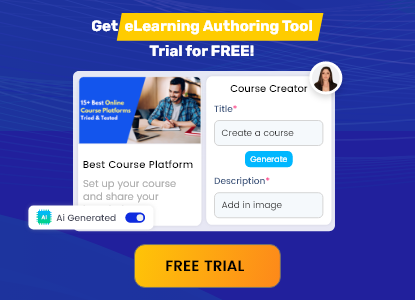In today’s fast-paced digital learning environment, rapid authoring tools have become indispensable for instructional designers, corporate trainers, and eLearning professionals. These tools have revolutionized content creation, making it faster, more efficient, and highly interactive. But how did we get here? Understanding the evolution of rapid authoring tools—from their inception to their current state and future trends—can help educators and organizations stay ahead of the curve. In this blog, we’ll explore the journey of these tools, their impact, and what lies ahead.
What Were the First Rapid Authoring Tools?
Key Highlights of Early Rapid Authoring Tools:
- Macromedia Authorware (acquired by Adobe) – One of the first tools that allowed instructional designers to create multimedia-rich courses without advanced coding.
- Adobe Flash – Dominated the early eLearning landscape, enabling interactive and animated learning experiences.
- Microsoft PowerPoint-Based Tools – Early versions of tools like Articulate Studio leveraged PowerPoint, making it easier to convert presentations into basic eLearning modules.
How Have Rapid Authoring Tools Evolved Over Time?
As technology advanced, so did rapid authoring tool. The rise of cloud computing, AI-driven development, and mobile-first learning drastically changed how eLearning content is created and consumed.
Key Milestones in the Evolution of Rapid Authoring Tools:
- Shift from Flash to HTML5 – With Flash being phased out, authoring tools embraced HTML5, making content more mobile-friendly and accessible.
- Rise of No-Code and Low-Code Platforms – Modern tools like CogniSpark AI, Articulate 360, iSpring, and Adobe Captivate allow content creation without programming knowledge.
- Cloud-Based Authoring – Platforms like CogniSpark AI, Elucidat and Easygenerator introduced cloud-based collaboration, enabling teams to work remotely and in real time.
- Interactive and Gamified Learning – The incorporation of gamification, VR/AR, and simulations enhanced learner engagement.
- AI and Automation – AI-driven tools now assist in content creation, language translation, and learner analytics.
What Is the Current State of Rapid Authoring Tools?
Current Features of Rapid Authoring Tools:
- Drag-and-Drop Functionality – Simplifies course creation without coding.
- Mobile Responsiveness – Ensures seamless learning across devices.
- AI-Powered Content Generation – Helps automate content creation and personalization.
- SCORM and xAPI Compliance – Ensures compatibility with Learning Management Systems (LMS).
- Collaboration Features – Supports remote teamwork and real-time editing.
Popular tools today include CogniSpark AI, Articulate Rise, Lectora, dominKnow, and Adobe Captivate, each offering unique strengths for different eLearning requirements.
What Does the Future Hold for Rapid Authoring Tools?
Predicted Trends in Rapid Authoring Tools:
- AI-Driven Course Development – AI will automate content creation, assessments, and even learner feedback.
- Adaptive Learning – Personalized learning paths based on individual progress and behavior.
- Extended Reality (XR) Integration – AR/VR simulations will become mainstream for hands-on training.
- Microlearning and Mobile Learning Optimization – Shorter, more interactive learning modules for on-the-go learners.
- Voice and Chatbot-Assisted Learning – Conversational AI will enhance learner interaction and support.
These innovations will make eLearning more accessible, efficient, and engaging than ever before.
Read More :- Advantages of Rapid Authoring Tools
Key Takeaways
- Rapid authoring tools have evolved from complex, Flash-based systems to AI-powered, cloud-based platforms.
- Modern tools offer interactive, mobile-friendly, and data-driven learning experiences.
- The future of rapid authoring tools will be shaped by AI, adaptive learning, and immersive technologies like AR/VR.
- Staying updated with these trends will help organizations create more effective and engaging learning solutions.
Final Thoughts: Stay Ahead with the Right Authoring Tool
As eLearning continues to evolve, choosing the right rapid authoring tool is crucial for effective content development. Whether you’re a corporate trainer, educator, or instructional designer, investing in modern, AI-driven tools will help you create more engaging, impactful learning experiences.
Are you looking for the best rapid authoring tool for your needs? Explore our expert reviews and comparisons to find the perfect fit for your organization!
About the author
Pradnya Maske
administrator
Pradnya Maske is a Product Marketing Manager with over 10+ years of experience serving in the eLearning industry. She is based in Florida and is a senior expert associated with Paradiso eLearning. She is passionate about eLearning and, with her expertise, provides valued marketing services in virtual training. Her background includes analyzing, designing, and developing marketing programs to grow and expand online learning programs. She is an expert in building product marketing strategies and working on market trends, competition and pricing. Her true passion lies in solving learning problems and making learning accessible to all.























